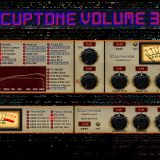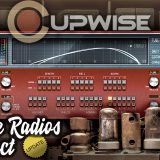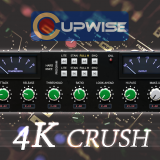Tube Amp EQ +bonus
An old Philco 6-tube amplifier has been extensively sampled to use as a unique tone-shaping tool in Nebula.
Product Description
Much time and effort went into making sure that the end results were faithful to the classic sounding hardware, which was sold with several phonograph consoles back in the 1950’s. For the main portion of this library, the EQ, it was sampled in 3 different hardware setups, for 3 different flavors. The ‘bass’ knob mostly acts as an adjustable high pass, and ‘treble’ as a shelf. Together they can also be used to create ’tilt-like’ eq setups (check the freq response graphs in manual to see what’s possible). The filter FX side of the library is a (nice) bonus.
All 3 ‘flavors’ of the EQ were sampled with dynamic behavior. Dynamics are very rare in Nebula EQ programs. Usually you have to pair an EQ program with another that includes the dynamics. Here, it’s all in one program. This way, with every possible position/combination of the bass/treble controls, you are getting a more complete representation of the amp. This requires more time to sample, but also results in much bigger and more complex programs. This requires a little more CPU than a usual Nebula EQ, but the sound is that much more authentic. To minimize the issue with the CPU, I’ve made ‘lite’ programs you can use which don’t have such full models as the standard ones, so you can use them to find the EQ settings you want before switching over to the higher quality versions before rendering.
Also included in the set are some custom made auto-wah effects. The Philco amp was also used in the creation of these, along with other things. Some of these programs use an envelope follower, so a peak filter (combined with the amp’s treble eq gain) moves in response to input audio. There are a few different versions of these programs which behave differently, with half going ‘up’ and the other half going ‘down’ in frequency as input level increases. There are other programs that use an LFO to control the filtering, with various LFO shapes. There are a LOT of possibilities with this side of the library, and I really couldn’t explain it all here. You would really have to use it for a while to get an idea of what’s possible, so I think it makes a really nice bonus to the EQ programs.
Be the first to comment on “Tube Amp EQ +bonus” Cancel reply
Demo program: grab a free set of demo programs here. Both 96khz and 44.1khz versions are included in the set. This is really the best way for you to get a good idea of how these things sound, even if the demos have some limitations (which are discussed in the .txt) and if it doesn't let you hear every program in the full set. Be sure to check the demos out!
These show off some of the different tones you can get with the Philco tube amp/EQ programs. Both clips use the same full mix. First clip uses amp/EQ #1 (only the amp was sampled). It starts with the dry mix, then the whole mix goes through the effect, and switches between different setting positions of the bass/treble control and various input drive levels (noise bursts between setting changes).
Next clip uses amp/EQ #3 (which also included FM transmission and a tube radio tuner in the signal chain). This clip doesn't include the dry mix (it is the same mix from the first clip), it goes right into different processed versions. As you can see (hear), this effect is more colored, because of the radio being added to the chain.
Here's a mix with drums and bass. Only the drums (not including the hats) ever go through the wah. The first one uses wah type A, the second uses type B. Both start with dry drums first, then processed. Static bursts separate program changes.
Also for the wah. It's a funky guitar. First you hear it dry, then it repeats, using different control setups each time, and both wah types A and B are used.
$17.00
All products include 44.1 and 96khz versions. Some have 48 and 88.2khz also.
The product description will mention that it includes 48 and 88.2khz if that is the case.
You will get all available sample rates for the product upon any purchase.
Featured Products
-
 Tube Delay Station
$38.00
Tube Delay Station
$38.00 -
 CupTone vol. 3 – Tone+Distortion
$41.00
CupTone vol. 3 – Tone+Distortion
$41.00 -
 Plates of Legend vol. 4x
$41.00
Plates of Legend vol. 4x
$41.00 -
 Plates of Legend vol. 1X
$40.00
Plates of Legend vol. 1X
$40.00 -
 M-Equalizer
$50.00
M-Equalizer
$50.00 -
 Assorted HPLP (+High Shelf) Mixing Filters
$22.00
Assorted HPLP (+High Shelf) Mixing Filters
$22.00 -
 Synth HP/LP Filters for Mixing, vol.1
$33.00
Synth HP/LP Filters for Mixing, vol.1
$33.00 -
 CupTone vol. 2
$39.00
CupTone vol. 2
$39.00 -
 CupReels Ax102
$41.00
CupReels Ax102
$41.00 -
 Cassette 3 – Multi Effects Pack
$39.00
Cassette 3 – Multi Effects Pack
$39.00 -
 Tube Radios Direct, Revamped
$40.00
Tube Radios Direct, Revamped
$40.00 -
 S-609A mk2 Bus Compressor + Limiter
$39.00
S-609A mk2 Bus Compressor + Limiter
$39.00 -
 Tube Radio Reverbs
$27.00
Tube Radio Reverbs
$27.00 -
 C660 mk3 Tube Compressor
$41.00
C660 mk3 Tube Compressor
$41.00 -
 4k Crush
$37.00
4k Crush
$37.00



Comments
There are no comments yet, would you like to submit yours?